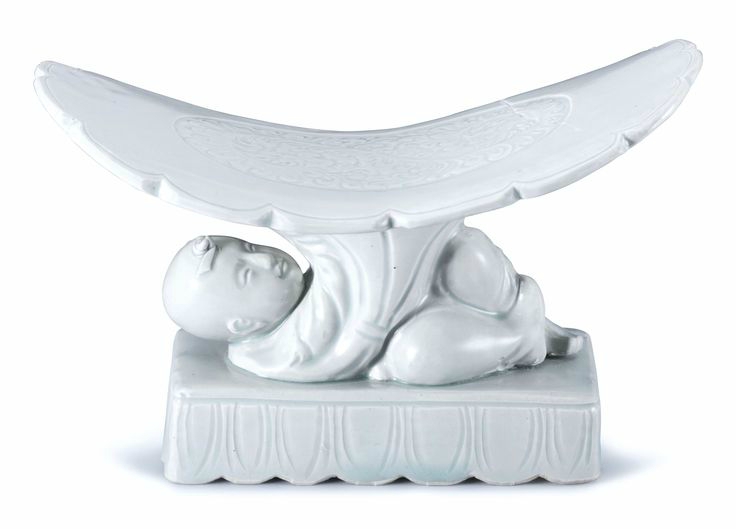A Qingbai 'boy' pillow, Southern Song dynasty
A Qingbai 'boy' pillow, Southern Song dynasty. Estimate 600,000 — 800,000 HKD (72,004 - 96,005 EUR). Photo Sotheby's.
the lower section finely modelled with a reclining young boy resting on his right side on a rectangular base simulating a bed, rendered with a gentle smile on his face, supporting a lobed curved panel, the oval centre of the panel finely incised with stylised foliate scrollwork - 25 cm., 9 3/4 in.
Notes: This charming piece belongs to a group of sculptural pillows produced in Jingdezhen kilns such as those of Hutian, Jiangxi province, during the Song dynasty (960-1279). Fragments of pillows of this type have been unearthed at these sites, such as one modelled in the form of a boy sleeping included in the exhibition Ceramic Finds from Jingdezhen Kilns, Fung Ping Shan Museum, 1992, cat. no. 70.
Two qingbai pillows of boys similarly modelled supporting a headrest in the form of a lotus leaf are illustrated in Rose Kerr,Song Through 21st Century Eyes. Yaozhou and Qingbai Ceramics, Dreumel, 2009, pls. 2-15 and 2-16. See also two qingbaipillows of this type but modelled in the form of a reclining lady, the first in the Metropolitan Museum of Art, New York, published in Stacey Pierson, Qingbai Ware. Chinese Porcelain of the Song and Yuan Dynasties, London, 2002, pl. 125, and the other illustrated in Rose Kerr, op. cit., pl. 2-17.
Symbolic of the wish for many children, the motif of boys was very popular in the Song dynasty and sculptural pillows of boys were produced at different kilns; compare a Ding pillow of closely related form in the Asian Art Museum, San Francisco, published in Sekai toji zenshu/ Ceramic Art of the World, Tokyo, 1977, vol. 12, pl. 12; and another in the Palace Museum, Beijing, illustrated in Selection of Ding Ware. The Palace Museum’s Collection and Archaeological Excavation, Beijing, 2012, pl. 42.
Sotheby's. Chinese Art. Hong Kong, 01 Jun 2015, 03:15 PM

/https%3A%2F%2Fprofilepics.canalblog.com%2Fprofilepics%2F1%2F0%2F100183.jpg)
/https%3A%2F%2Fstorage.canalblog.com%2F03%2F02%2F119589%2F96711876_o.jpg)
/https%3A%2F%2Fstorage.canalblog.com%2F11%2F31%2F119589%2F94773502_o.jpg)
/https%3A%2F%2Fstorage.canalblog.com%2F20%2F83%2F119589%2F94772815_o.jpg)
/https%3A%2F%2Fstorage.canalblog.com%2F26%2F72%2F119589%2F75604929_o.jpg)
/https%3A%2F%2Fstorage.canalblog.com%2F59%2F60%2F119589%2F26458628_o.jpg)



/image%2F1371349%2F20240412%2Fob_e3109f_2024-nyr-22642-0929-000-a-carved-qingb.jpg)
/image%2F1371349%2F20240411%2Fob_a3392b_2024-nyr-22642-0917-000-a-qingbai-foli.jpg)
/image%2F1371349%2F20240406%2Fob_b6629b_434639765-1646435522793127-51895182157.jpg)
/image%2F1371349%2F20240406%2Fob_53c757_435758154-1646430439460302-28934857903.jpg)